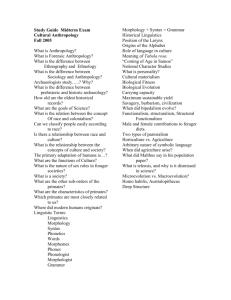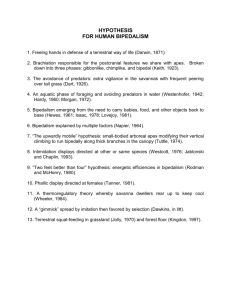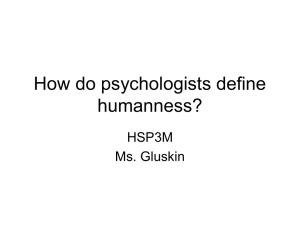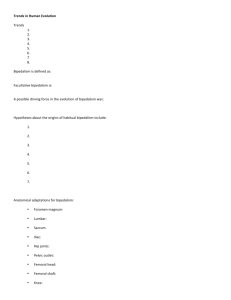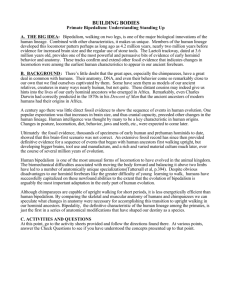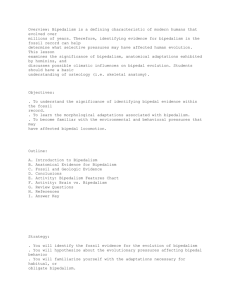CHAPTER 1: WHAT IS PHYSICAL ANTHROPOLOGY?
advertisement
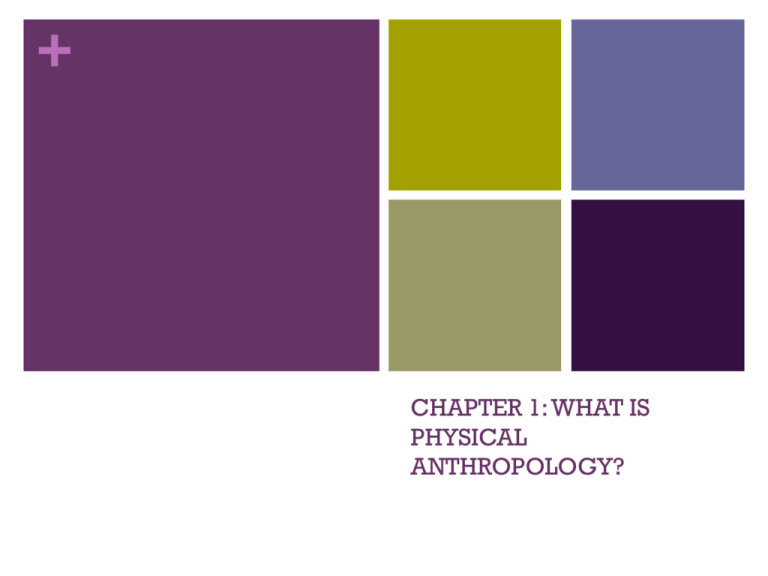
+ CHAPTER 1: WHAT IS PHYSICAL ANTHROPOLOGY? + ANTHROPOLOGY Definition: the study of humankind Four branches: Cultural Studies culture, or learned, transmitted behavior of living people Archaeology Studies culture of past societies by analyzing artifacts Linguistic Studies study construction and evolution of language Physical/biological Studies relationship of biology and culture + PHYSICAL/BIOLOGICAL ANTHROPOLOGY Definition: the study of human evolution and biocultural variation Use fossils, genetics, comparative anatomy and behavior Hominids: ape and human ancestors Hominins: ancestors of only humans Genes influence biology but the environment does as well Study: evolution of both extinct and living human relatives, including modern primates + PHYSICAL/BIOLOGICAL ANTHROPOLOGY Why would anyone want to study bones and teeth? They tell us about anatomy, diet, behavior, locomotion, and our place in nature Questions we look to answer: Who are we as a species? What does it mean to be human? Where did we come from? How do we fit in with other living things? + SIX STEPS TO HUMANNESS We are connected to other living things, but clearly we are unique (1) bipedalism (2) nonhoning canine (3) material culture and tool use (4) hunting (5) speech (6) domesticated food + SIX STEPS TO HUMANNESS (1) bipedalism: Physical difference of walking on two legs Other primates can do this, but only for short times Major adaptations in anatomy Double curved spine Wide pelvis Arch in foot + SIX STEPS TO HUMANNESS (2) nonhoning canine Loss of large canines Loss of diastema Because of use of tools to process food (3) material culture and tools Completely depend on culture to survive Manipulate environment Tools date more than 2.5 million years ago Primates use tools, but only humans use stone tools + SIX STEPS TO HUMANNESS (4) hunting Social, organized More than 1 million years ago Before, we were scavengers (5) speech Due to bipedalism Hyoid and voice box position (6) domestication of food 10,000 years ago Huge impact on biology and behavior + HOW WE KNOW We use the scientific method Difference between casual and scientific definitions: Hypothesis: testable statement of the relationship between 2 variables NOT “an educated guess” Theory: best explanation possible, with validation and testable evidence NOT just a story someone comes up with Things are never proven and we always stay open-minded + SCIENCE The scientific method involves: + HOW WE KNOW You cannot prove something right in science You can only disprove something We say that evolution is a fact because there is so much evidence in support of it Always keep open-minded because science is selfcorrecting It is a fact and a theory + WHAT IS EVOLUTION An easy definition is “change over time” Does it mean we descended from monkeys? Does it try to disprove the Bible? Do you have to choose between science and religion? + WHAT IS EVOLUTION An easy definition is “change over time” Does it mean we descended from monkeys? Does it try to disprove the Bible? Do you have to choose between science and religion? NO!!! + EVOLUTION AND RELIGION Why do people think they are in opposition? One uses testable evidence, and the other uses faith You can, and should, have both science and beliefs When people say “evolution is just a theory” they are misusing the term theory Evolution is not a straight line; it is a branching bush NO! + EVOLUTION So, did a fish just decide to walk out of the water one day? Did an ape just decide to come down from the trees and turn human? + EVOLUTION It is a very gradual process that can take millions of years The lobe-finned fish, or lungfish, is alive today It has bones in its fins and a pocket to store air Can move from one body of water to another by walking on ground They are precursor to tetrapods, or land-dwelling anmials There There is not one ‘missing link’ are hundreds or thousands and we will study many in this class + EVOLUTION + + DARWIN Made his observations while traveling the world Saw evidence in morphology and though humans had arboreal ancestor Observing finches showed him adaptations Observing overpopulation and competition led him to create theory of natural selection Alfred Wallace also had the same idea at the same time…Darwin just beat him to publication + The Scopes Monkey Trial in 1925 http://findcartoon.com/the-simpsons-season-17-episode-21the-monkey-suit/#.VQtrfin4vlI + View I want you to be able to see the world in a different way after this class How are things connected? How has evolution shaped living things? How can we learn from the past to prepare for the future? + How did these guys get this way…? + Video Keep this in mind during the video of deep sea creatures Focus on how they are tailored to their environment through evolution + Here are some questions to ponder: What is the difference between the casual and scientific definitions of hypothesis and theory? How has the human body changed because of bipedalism? Are humans the only species to use tools? How can someone study evolution and still keep his or her religious beliefs?
